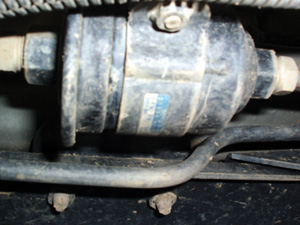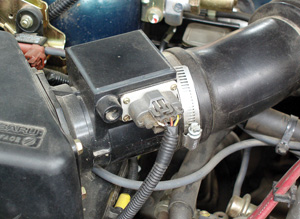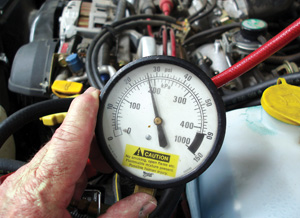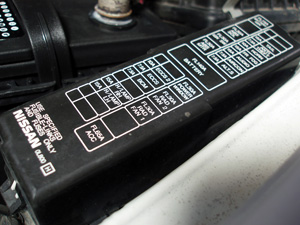f in-tank electric fuel pumps returned for warranty aren’t truly defective. Unfortunately, many amateur and professional technicians assume that, because they can’t hear the typical whining noise that a good fuel pump makes when the ignition is first turned on, the fuel pump itself is to blame. If that assumption is the sole rationale for replacing the fuel pump, you’re probably going to see the pump back on warranty return.
 THREE BASIC FUEL PUMP CONFIGURATIONS
THREE BASIC FUEL PUMP CONFIGURATIONS
Before we discuss fuel pump diagnosis, let’s look at three basic fuel pump configurations. Early dual fuel line fuel pump configurations consisted of a fuel pump, fuel filter, fuel pressure regulator, fuel pump relay and, in some applications, oil pressure-activated or inertia-activated safety switch. When the ignition is turned on in these systems, the pump is momentarily activated to pressurize the fuel injectors. As the engine is cranked, the crankshaft position sensor indicates to the PCM that the engine has reached a minimum cranking speed of about 250-300 rpm. At that point, the PCM re-activates the fuel pump. In some applications, an oil pressure safety switch will activate the fuel pump circuit as oil pressure builds up in the engine.
During the late ’90s, auto manufacturers began consolidating fuel pump components into a single fuel line system in which the fuel pump, fuel pump filter, fuel level sensor, and fuel pressure regulator are integrated into the fuel pump module. Most of these systems rely on the crankshaft position sensor to act as a safety switch to deactivate the fuel pump if the engine stalls. If the vehicle is involved in a collision or rollover accident, modules associated with safety-related devices like the air bags might be also used to deactivate the fuel pump in some applications.
Pulse-modulated fuel pumps are the latest variation in fuel delivery systems. While pulse-modulated systems are generally modular designs, the fuel pump speed and fuel pressure are controlled by the PCM through an external fuel pump module. In most cases, pulse-modulated systems require the tooling and expertise of the professional technician to diagnose and repair.
 WHY FUEL PUMPS FAIL
WHY FUEL PUMPS FAIL
Any in-tank electric fuel pump has a normal service life. In some applications, that service life might be as little as 60,000 to 80,000 miles. One of the reasons for a shortened service life is that the fuel pump design can’t withstand sustained high-load conditions. In some cases, the aftermarket has upgraded these pumps to increase their service lives.
Dirty fuel can also be responsible for premature fuel pump wear. If the fuel filter is contained in the fuel pump module, dirt clogs the filter and the fuel pump begins to actually draw a partial vacuum inside the fuel filter. This partial vacuum causes bubbles to form in the fuel line which, in turn, causes a loss of fuel pressure.
If the system has an external fuel filter that has become clogged with dirt, the fuel pump begins working much harder to push fuel through the filter. Because the increased load will rapidly wear the fuel pump out, some fuel pump manufacturers won’t warranty a new fuel pump without a new fuel filter being installed.
If the fuel tank has been contaminated with dirty fuel, it should be washed with pressurized soap and water and then thoroughly dried with warm air. Fuel tanks with extensive baffling should be replaced because they often can’t be effectively cleaned. It’s important to emphasize that fuel should never be added to a modern fuel tank from a dirty gas can or from an external fuel storage tank that isn’t properly vented and filtered.
 RELATED COMPONENT FAILURES
RELATED COMPONENT FAILURES
Related component failures like stuck fuel pressure regulators can reduce fuel pressure and thus mimic a worn fuel pump. Another factor that can mimic a worn fuel pump is badly deteriorated gasoline. While this condition is relatively rare, it’s entirely possible to fill a vehicle with gasoline from which all of the “light-end” fuel components have long ago evaporated. Symptoms generally include hard starting and lack of throttle response and power.
Last, the PCM can miscalculate the air/fuel ratio because it’s receiving false input data from a faulty throttle position sensor, ambient air or coolant temperature sensor, or mass air flow (MAF) sensor. Because these false data inputs often cause a lean-fuel condition that mimics a worn fuel pump, the fuel pump is replaced without curing the problem. Here again, the services of a well-trained technician equipped with a professional scan tool is required to diagnose false sensor data inputs.
ELECTRICAL PROBLEMS
All modern vehicles are equipped with safety mechanisms that deactivate the fuel pump if the engine stalls or if the vehicle is involved in a collision. To illustrate, the mechanical air flow sensors on early import vehicles incorporated a fuel pump switch that was designed to deactivate the fuel pump if the engine stalled. The pump would be re-activated during cranking and start-up. Technicians need to be aware that the fuel pump won’t activate if the ducting between the air flow sensor and the engine throttle plate is leaking or missing.
Ford Motor Co. often uses an inertia switch to deactivate the fuel pump in an impact collision. The vehicle owner’s manual is usually the best guide for locating the inertia switch. The inertia switch also is usually the best location for testing the fuel pump electrical system. Keep in mind that it’s common for an inertia switch to disengage during severe off-road driving or a minor collision. Simply pushing the red button located at the top of the inertia switch will reset the switch.
 Oil pressure switches are generally used to provide a safety backup for the fuel pump relay or as an emergency shut-off if the engine loses oil pressure. In any case, a fuel pump wiring schematic will reveal the presence and function of a fuel pump oil pressure switch on any specific vehicle application.
Oil pressure switches are generally used to provide a safety backup for the fuel pump relay or as an emergency shut-off if the engine loses oil pressure. In any case, a fuel pump wiring schematic will reveal the presence and function of a fuel pump oil pressure switch on any specific vehicle application.
Some 1980s and early 1990s vehicles incorporated fuel pump test connections either in the engine wiring harness or, in the case of Ford vehicles, at the diagnostic connector. Because some of these early electric fuel pumps were grounded to the vehicle’s frame, it’s always important to clean and lubricate the frame ground connection during testing and installation. Because many General Motors applications had problems with the electrical connector at the fuel tank either corroding or melting, most fuel pump manufacturers include a new pigtail that should be installed in the wiring harness along with the new fuel pump.
SCAN TOOL TESTING
The simplest method for testing post-1996 OBD II fuel pump electrical systems is to connect a professional scan tool to the vehicle’s OBD II diagnostic port and use the scan tool’s bi-directional controls to activate the fuel pump relay. If the relay makes a clicking noise without activating the fuel pump, the fuel pump relay, wiring, or fuel pump motor is defective.
If the fuel pump activates, it should be tested for specified pressure and volume. If the volume is low, the external fuel filter should be inspected and, in most cases, replaced. If the pressure is excessively high or low, the fuel pressure regulator might be at fault. If the system is equipped with an external fuel pressure regulator and the fuel pressure is too high, the regulator might be stuck closed or the return fuel line to the fuel tank might be restricted.
I might also mention that a malfunctioning vehicle anti-theft system, remote starting system or defective ignition key can cause a failure of the fuel pump to activate. The symptom is the engine stalling shortly after start-up. In any of the above scenarios, the anti-theft module is failing to identify the ignition key. In one case I experienced, the fuel pump was replaced without result. The real problem was that the identification chip had fallen out of the ignition key. Here again, it’s important to refer these types of problems to a professional technician who’s equipped to analyze the problem.
Gary Goms is a former educator and shop owner who remains active in the aftermarket service industry. Gary is an ASE-certified Master Automobile Technician (CMAT) and has earned the L1 advanced engine performance certification. He is also a graduate of Colorado State University and belongs to the Automotive Service Association (ASA) and the Society of Automotive Engineers (SAE).













